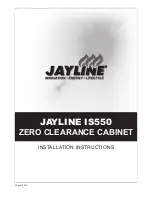
38745-4-0319
Page 30
VERTICAL TERMINATION (CONT’D)
Locate and mark the center point of the vent pipe using a nail on
the underside of the roof. Drive the nail through the center point.
mark the outline of the roof hole around this center point.
NOTE:
Size of the roof hole dimensions depend on the pitch of the
roof. There must be a 1 inch (25 mm) clearance to the vertical pipe
sections. This clearance is to all combustible material.
Cover the opening of the vent pipe and cut and frame the roof hole.
Use framing lumber the same size as the roof rafters and install the
frame securely. Flashing anchored to frame must withstand high
winds. The storm collar is placed over this joint to make a water-tight
seal. Non-hardening sealant should be used to completely seal this
flashing installation.
Determining Minimum Vent Height Above the Roof.
WARNING
Major U.S. building codes specify minimum chimney and/or
vent height above the roof top. These minimum heights are
necessary for safety. These specifications are summarized
in Figure 63.
ROOF PITCH
H (Min.)
Flat to 6/12
12" (305 mm)
6/12 to 7/12
15" (381 mm)
over 7/12 to 8/12
18" (457 mm)
over 8/12 to 16/12
24" (610 mm)
over 16/12 to 21/12
36" (914 mm)
Figure 63
For steep roof pitches, increase the vent height. High -wind conditions,
nearby trees, adjoining roof lines, steep pitched roofs, and other
factors can result in poor draft, or down-drafting. In these cases,
increasing the vent height may solve this problem.
General Maintenance
Inspect venting system semi-annually as follows:
1. Check for corrosion areas of the venting system exposed to
the elements. These will appear as rust spots or streaks and,
in extreme cases, holes. Replace damaged components should
immediately.
2. Remove the cap and shine a flashlight down the vent. Remove
any bird nests or other foreign material.
3. Check for evidence of excessive condensate, such as water
droplets forming in the inner liner and subsequently dripping
out at joints. Condensate can cause corrosion of caps, pipe and
fittings. It may be caused by having excessive lateral runs, too
many elbows and exterior portions of the system being exposed
to cold weather.
4. Inspect joints to verify that no pipe sections or fittings have been
disturbed or loosened. Also, check mechanical supports, such
as wall straps or plumbers’ tape for rigidity.
Venting termination shall not be recessed into a wall or siding.
A removable panel or other means must be provided in the enclosure
for visual inspection of the flue connection.
NOTE:
This also pertains to vertical vent systems installed on the
outside of the building.
Slide the vertical vent cap over the end of the vent pipe and secure.
See Figure 64.
Installing the vent System in a Chase
A chase is a vertical box-like structure built to enclose the gas
appliance and/or its vent system. Though not normally required,
vertical vent runs on the outside of a building may be installed
inside a chase.
Figure 64
CAUTION
Treatment of firestop spacers and construction of the chase
may vary with the type of building. These instructions are
not substitutes for the requirements of local building codes.
Check local building codes to determine the requirements
for these steps.
NOTE:
Build the chase large enough to the minimum clearance
of combustible materials (including insulation) to the vent system.
When installing the vent system in a chase, insulate the chase as you
would the outside walls of your home. This is especially important
in cold climates. Upon completion of chase framing, install the vent
system by following the instructions in this manual.
















































